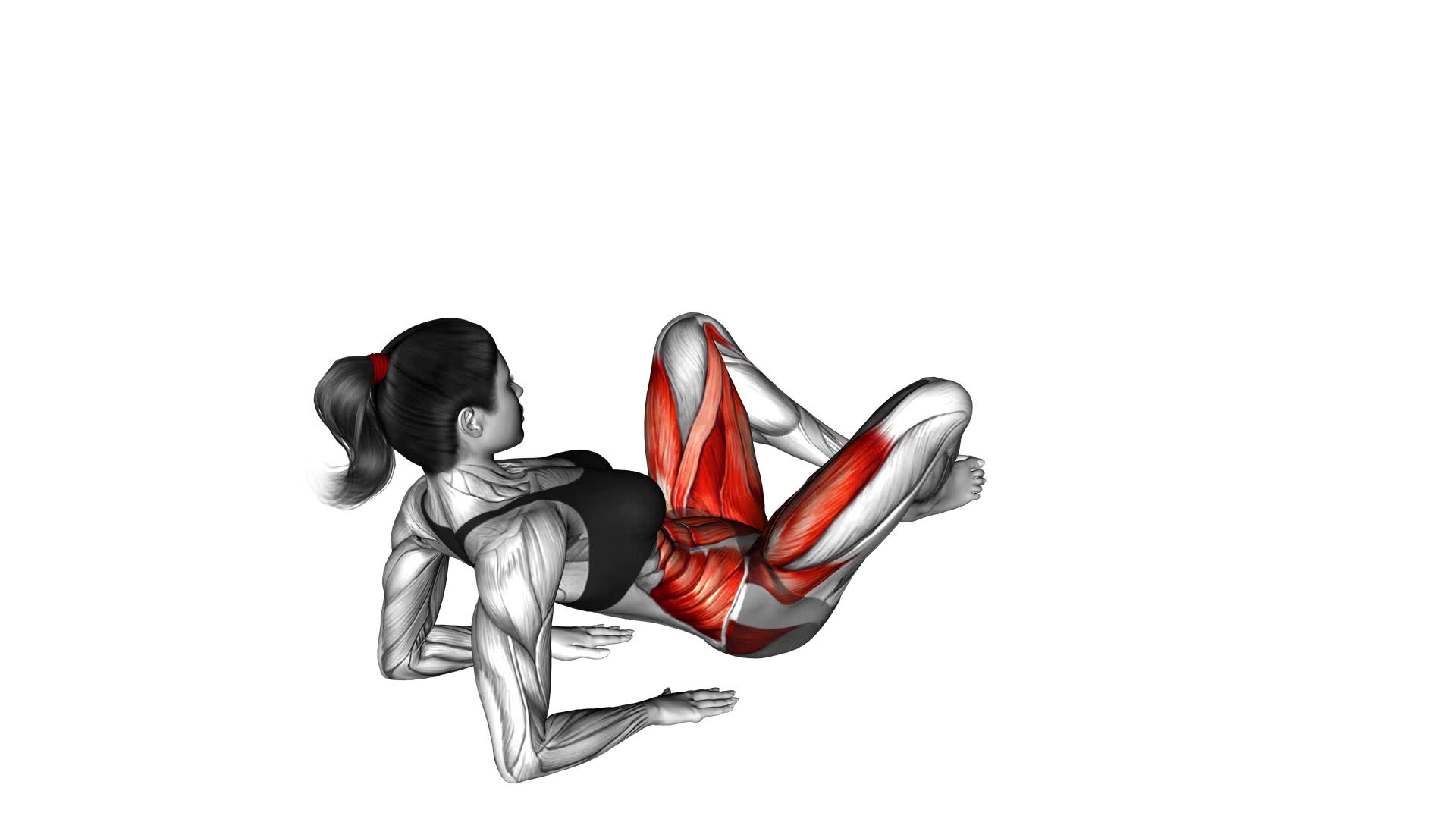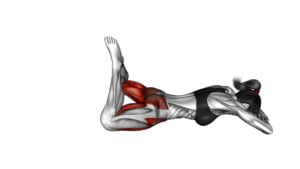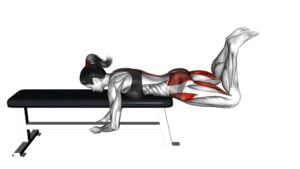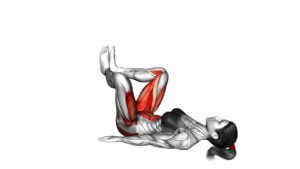Reverse Frog Crunch (female) – Video Exercise Guide & Tips

Are you looking for an effective ab workout that targets your core muscles? Look no further than the Reverse Frog Crunch.
Watch This Exercise Video
This exercise is perfect for women who want to strengthen their abs and improve their overall fitness.
In this video exercise guide, you'll learn the proper form and technique, as well as common mistakes to avoid.
With modifications for different fitness levels and tips for maximizing effectiveness, this workout is sure to help you reach your fitness goals.
Key Takeaways
- Engages core muscles
- Improves abdominal strength
- Targets rectus abdominis, obliques, and transverse abdominis
- Stabilizes the spine
Benefits of the Reverse Frog Crunch
You can achieve numerous benefits from performing the Reverse Frog Crunch through engaging your core muscles and improving your overall abdominal strength. This exercise primarily targets the rectus abdominis, obliques, and transverse abdominis. These muscles play a crucial role in stabilizing your spine and improving your posture. By regularly incorporating the Reverse Frog Crunch into your workout routine, you can develop a strong and defined midsection.
To progress and increase the difficulty of the Reverse Frog Crunch, you can make a few adjustments. First, you can add resistance by holding a weight plate or dumbbell against your chest. This will challenge your muscles further and promote additional strength gains. Another option is to perform the exercise on an unstable surface, such as a stability ball. This will require more core stability and coordination. Finally, you can increase the number of repetitions or sets, or decrease the rest time between sets, to make the exercise more challenging.
Remember to maintain proper form throughout the movement. Lie on your back with your knees bent and feet flat on the floor. Place your hands behind your head, engage your core, and lift your shoulders off the ground while bringing your knees towards your chest. Pause for a moment, then slowly lower back down to the starting position. Keep your movements controlled and avoid putting strain on your neck and lower back.
Incorporating the Reverse Frog Crunch into your fitness routine can help you achieve a stronger core and improve your abdominal strength.
Proper Form and Technique for the Exercise
To perform the Reverse Frog Crunch with proper form and technique, ensure that your back is flat on the ground and your knees are bent with your feet flat on the floor. This position helps to protect your lower back and engage your abdominal muscles effectively. Some common misconceptions about this exercise involve lifting your shoulders off the ground and using momentum to complete the movement. However, it's important to remember that the focus should be on engaging your core muscles and using controlled movements.
Start by lying on your back with your arms resting by your sides. Bend your knees and place your feet flat on the floor, hip-width apart. Keep your back flat against the ground throughout the exercise. Inhale deeply, and as you exhale, engage your core muscles and slowly lift your feet off the ground, bringing your knees towards your chest. Hold this position for a moment, feeling the contraction in your abdominal muscles. Then, slowly lower your feet back to the starting position, inhaling as you do so.
If you find the Reverse Frog Crunch too challenging or if you want to switch up your routine, there are alternative exercises you can try. Some options include the traditional crunch, the bicycle crunch, or the plank exercise. These exercises target your abdominal muscles and can help you achieve similar results. Remember to always consult with a fitness professional or trainer to ensure proper form and technique for any exercise you choose to incorporate into your routine.
Common Mistakes to Avoid During the Workout
One common mistake to avoid during the workout is failing to maintain proper form and technique. Proper form is crucial in order to maximize the effectiveness of the exercise and prevent injuries.
One common mistake is using momentum instead of engaging your core muscles. This can happen when you swing your legs up and rely on the momentum to lift your upper body. Instead, focus on using your abdominal muscles to lift your upper body and keep your movements controlled.
Another mistake to avoid is rounding your back during the exercise. This can put unnecessary strain on your spine and decrease the effectiveness of the workout. Make sure to keep your back straight and your core engaged throughout the movement.
Lastly, it's important to avoid rushing through the exercise. Take your time and focus on each repetition, ensuring that you're performing the exercise with proper form.
Modifications and Variations for Different Fitness Levels
To modify the Reverse Frog Crunch exercise for different fitness levels, consider adjusting the range of motion and adding resistance to increase the challenge. For individuals with limited mobility, adaptations can be made to make the exercise more accessible.
One option is to reduce the range of motion by not bringing the knees as close to the chest. This can help those with mobility issues perform the exercise with less strain on their joints. Another adaptation is to perform the exercise on a stability ball instead of the floor. This provides additional support and stability, making it easier for individuals with limited mobility to engage in the movement.
On the other hand, for advanced fitness enthusiasts looking to progress the exercise, there are several options. One progression is to increase the range of motion by bringing the knees closer to the chest or even extending the legs straight up in the air. This challenges the abdominal muscles even more and requires greater core strength. Another progression is to add resistance by holding a dumbbell or medicine ball between the feet. This increases the load on the abdominal muscles, making the exercise more challenging.
Tips for Maximizing the Effectiveness of the Reverse Frog Crunch
To maximize the effectiveness of the Reverse Frog Crunch, focus on engaging your core muscles throughout the entire exercise. This will help you target your abdominal muscles and prevent lower back pain. As you perform the crunch, concentrate on pulling your belly button towards your spine and contracting your abs. This will ensure that your core is fully activated, leading to better results.
In addition to engaging your core, paying attention to your breathing can also enhance the effectiveness of the Reverse Frog Crunch. Exhale as you lift your upper body off the ground and contract your abs, and inhale as you lower yourself back down. This controlled breathing pattern will help you maintain stability and control during the exercise, allowing you to fully engage your core muscles.
By focusing on engaging your core muscles and using proper breathing techniques, you can maximize the effectiveness of the Reverse Frog Crunch and avoid lower back pain.
Now that you know these tips, let's move on to the next section where we'll discuss a sample workout routine that incorporates the Reverse Frog Crunch.
Sample Workout Routine Incorporating the Reverse Frog Crunch
Start by incorporating the Reverse Frog Crunch into your workout routine for a targeted core workout. This exercise is great for strengthening your abdominal muscles and improving your overall core stability.
To get the most out of your workout, consider the following sample workout modifications and alternative core exercises:
- Begin your workout with a 5-minute warm-up to prepare your muscles for exercise.
- Perform 2-3 sets of 10-12 reps of Reverse Frog Crunches, focusing on maintaining proper form and engaging your core muscles throughout the movement.
- Rest for 30-60 seconds between sets to allow your muscles to recover.
- To add intensity, you can hold a dumbbell or medicine ball against your chest while performing the Reverse Frog Crunch.
- Incorporate other core exercises such as planks, Russian twists, or bicycle crunches to target different areas of your core.
- Remember to listen to your body and modify the exercises as needed. If you experience any pain or discomfort, stop the exercise and consult a healthcare professional.
Frequently Asked Questions
How Many Calories Can I Burn by Doing the Reverse Frog Crunch?
You can burn calories by doing the reverse frog crunch. It's an effective exercise that engages multiple muscles, including your abs, thighs, and glutes.
The exact number of calories burned will depend on various factors such as your weight, intensity, and duration of the workout.
To maximize calorie burn, you can try different variations and modifications of the reverse frog crunch, such as adding weights or increasing the number of repetitions.
Can the Reverse Frog Crunch Help Reduce Belly Fat?
The reverse frog crunch is a great exercise for targeting your abs and reducing belly fat. When comparing it to the traditional crunch, the reverse frog crunch can be more effective due to its increased activation of the lower abdominal muscles.
However, it's important to note that reducing belly fat requires a combination of exercise and a healthy diet. While the reverse frog crunch alone can make a difference, incorporating it into a well-rounded fitness routine and maintaining a balanced diet will yield more significant results.
Is the Reverse Frog Crunch Suitable for Pregnant Women?
The reverse frog crunch may not be suitable for pregnant women due to the strain it puts on the abdominal muscles and the pressure it places on the pelvic floor.
However, there are pregnancy modifications and alternative exercises that can be done to target the same muscles without risking any harm to you or your baby.
It's important to consult with your healthcare provider or a certified prenatal fitness specialist to ensure you're doing safe and effective exercises during pregnancy.
Can I Do the Reverse Frog Crunch if I Have Lower Back Pain?
If you have lower back pain, it's best to avoid the reverse frog crunch. This exercise puts strain on your lower back and could exacerbate your pain.
However, there are modifications you can do to make it more suitable, such as placing a pillow under your lower back for support.
Alternatively, you can try other exercises that target your core without putting strain on your lower back, like planks or bird dogs.
How Often Should I Include the Reverse Frog Crunch in My Workout Routine?
To maximize the benefits of core strength, it's recommended to include the reverse frog crunch in your workout routine. This exercise targets the abdominal muscles, helping to tone and strengthen them.
You can vary the intensity by trying different variations of the reverse frog crunch, such as adding weights or performing it on an unstable surface. Remember to listen to your body and adjust the frequency based on your fitness level and recovery ability.
Conclusion
In conclusion, the reverse frog crunch is an effective exercise for targeting the core muscles, particularly the lower abs.
By maintaining proper form and technique, avoiding common mistakes, and incorporating modifications for different fitness levels, individuals can maximize the effectiveness of this exercise.
Adding the reverse frog crunch to a well-rounded workout routine can help strengthen and tone the abdominal muscles, leading to improved core stability and overall fitness.

Author
Years ago, the spark of my life’s passion ignited in my mind the moment I stepped into the local gym for the first time. The inaugural bead of perspiration, the initial endeavor, the very first surge of endorphins, and a sense of pride that washed over me post-workout marked the beginning of my deep-seated interest in strength sports, fitness, and sports nutrition. This very curiosity blossomed rapidly into a profound fascination, propelling me to earn a Master’s degree in Physical Education from the Academy of Physical Education in Krakow, followed by a Sports Manager diploma from the Jagiellonian University. My journey of growth led me to gain more specialized qualifications, such as being a certified personal trainer with a focus on sports dietetics, a lifeguard, and an instructor for wellness and corrective gymnastics. Theoretical knowledge paired seamlessly with practical experience, reinforcing my belief that the transformation of individuals under my guidance was also a reflection of my personal growth. This belief holds true even today. Each day, I strive to push the boundaries and explore new realms. These realms gently elevate me to greater heights. The unique combination of passion for my field and the continuous quest for growth fuels my drive to break new ground.







